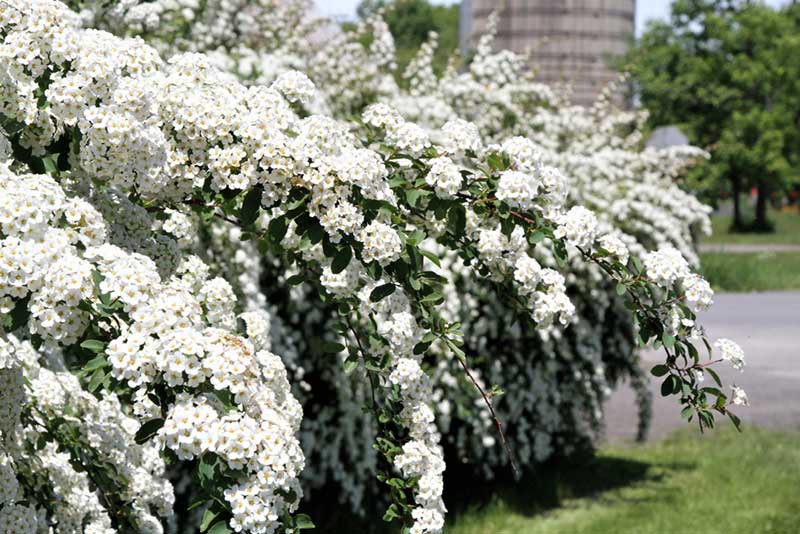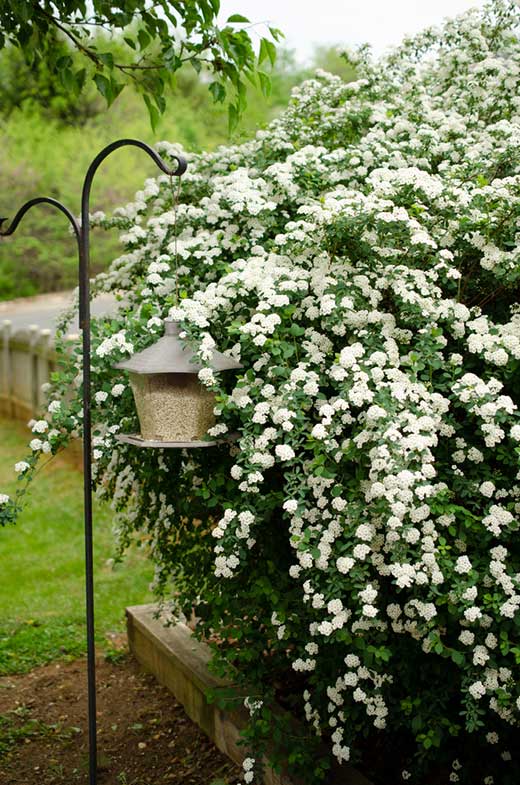
Spirea (Spirea sp) is a deciduous shrub (it loses it foliage in winter) that thrives in USDA plant hardiness zones 3 through 9, depending on the species and variety.
While there are about 80 species in the group, they are typically divided into two groups. Spring and summer blooming spirea.
Most spring blooming spirea produce cascades of white blooms on arching branches while summer blooming varieties produce flowers in shades of pink and red as well as white.
Spirea ranges in height from tiny 1-foot varieties to shrubs that reach heights of 8 feet or more with an equal spread. Foliage color ranges from green, blue, gold and chartreuse.
Many put on a show in the fall long after the blooms have faded with foliage that turns bright red. Foliage can be fine and lacy or broad-leaf, depending on the variety.
Spirea flowers attract a host of flying insects including bees and butterflies and bring your garden alive with color and movement.
Light and Temperature Requirements
Spirea thrives in full sun but will tolerate partial shade. Try to give your spirea shrub at least 6 hours of direct sunlight a day. Without adequate sunlight spirea shrubs will be stunted and will produce smaller and fewer blooms.

Watering
Spirea shrubs prefer moist soil but will suffer if the soil remains soggy. Plant them in a location where the soil drains well. Water them when the soil feels dry 1 inch below the surface. It is best to water them deeply, so the water reaches the root level. This causes the roots to form deep in the earth. Frequent shallow watering causes roots to form near the surface of the soil compromising the root system. Mulch with bark or other organic mulch to control weeds and help retain moisture.
Soil and Fertilizing
Spireas prefer well-drained soil that is slightly acidic to neutral with a pH between 6 and 7. If you are unsure of the pH of your soil you can purchase an inexpensive soil test kit at your local hardware store to measure it. Follow the instructions for taking and measuring the soil sample. Your kit will also include recommendations for adjusting the soil pH.
Fertilizing spirea shrubs is quick and easy. Use fertilizer spikes or formulas designed for flowering shrubs in the early spring when new growth first appears. Follow the instructions on the container using care to apply it at the correct rate. Resist the urge to use more spikes or more fertilizer than recommended. This is one time when more is not better.
Deadheading and Pruning
Deadheading refers to removing old or faded blooms from a plant. Use clippers to cut the old or faded flowers from the shrub before they can go to seed. This tricks the plant into thinking it has not produced enough seeds to reproduce. To compensate the shrub will send out new flowers to replace those that have been deadheaded.
Prune spring blooming spireas soon after the have ceased blooming as the buds for next year’s blooms form in the summer. Waiting too long to prune the shrubs may result in cutting off the buds and will inhibit blooming the following year. Remove any dead of weak canes at this time by cutting them back to the ground level. This also the time to remove branches that cross the center of the shrub and block light to the interior. Trim the ends of branches back to maintain the overall shape at this time.
Prune summer blooming spireas in the winter or early spring following the same procedure used for pruning spring blooming spirea. You can also cut the entire spirea back to the ground at this time if it has become scraggly or ungainly. This will force new growth in the spring and create a dense compact shrub.

Propagation
Spirea can be propagated via softwood cutting in the summer. Once they are rooted the cuttings will grow into shrubs identical to the parent. Here’s how:
- Cut 4-to-6-inch cuttings from the growing tips of you spirea shrub. The wood should still be flexible and bend easily, but it should still snap in two under pressure.
- Pinch out the tiny leaves on the growing tip and remove all but 2 to 3 leaves on the stem. The bottom 2 inches of the stem should be free of foliage.
- Dip the end of the stem in rooting powder and tap it to remove the excess powder.
- Fill an 8-inch plant pot with moist potting mixture.
- Insert the cuttings into the soil. You can root 4 to 6 cuttings in the same pot.
- Cover the pot and cuttings with a plastic bag to hold in moisture.
- Place the cuttings in area with bright indirect light to root.
- Check them periodically and water them if the soil dries out.
- Re-pot the cuttings to individual pots once roots are established in about 30 days.
- Grow them in a sheltered location through the winter and transplant them to a sunny area in the spring.
Spireas can be used as specimen plants, added to perennial beds or used to highlight a walkway or seating area. These delightful flowers add interest to the yard from spring to well into the fall, especially if you choose a variety with colorful foliage.




